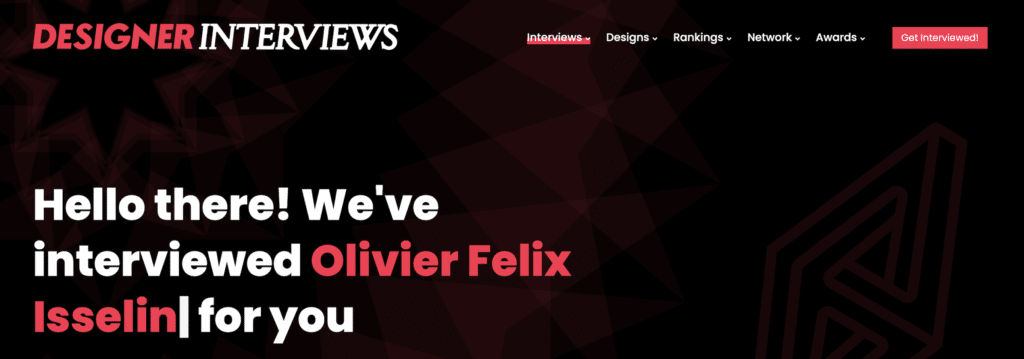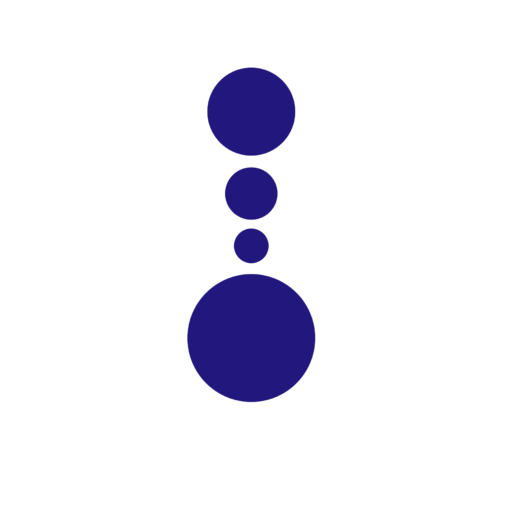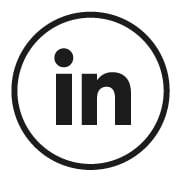
Interview by Frank Scott – Tuesday 23 May 2023.
Designer Interview of Olivier Felix Isselin:
DI: Could you please tell us more about your art and design background? What made you become an artist/designer? Have you always wanted to be a designer?
OFI : As a child, my favorite game was Lego: I enjoyed posing problems to myself and finding solutions. I also spent a lot of time making plans and discussing projects with my grandfather, an Italian entrepreneur settled in France. Furthermore, my relationship with aesthetics has always been essential to me: I have always lived in beautiful places, which undoubtedly greatly contributed to my development. Later on, I studied architecture in Paris. However, I quickly realized that I didn’t want to finish that course. After spending some time with an architect, I understood that this profession, as it is practiced, would not suit me: creative freedom was too quickly restricted, and there were too many administrative constraints… It should be mentioned that alongside my studies, I was in charge of the artistic direction of major events in Paris (Centre Pompidou, Conciergerie, Hôtel de Sully, etc.). A choice had to be made… Subsequently, I notably managed several contemporary art galleries, curated exhibitions, and created and oversaw the execution of various spaces… My relationship with artists has also had a significant impact on me. In short, to keep it brief, my entire career path has been that of a free man, merging my passions with my work and vice versa. Design is the obvious continuity of my life journey.
DI: Can you tell us more about your company / design studio?
OFI : As an independent, I manage my own design studio. I am responsible for all stages of the design process, from idea generation to final realization.
DI: What is « design » for you?
OFI : Design, for me, is primarily defined by its relationship to space. While being an artist involves having an intense and personal perception of one’s environment and expressing it freely through various mediums, with art being the result of this process, design distinguishes itself in the sense that it is not solely focused on its creator, but rather it primarily addresses the user and is thus closely linked to functionality. Technique, materials, and ergonomics are among the elements to consider during the creation process. Design represents the response to a problem. However, this doesn’t mean that the designer is not also an artist. In addition to solving problems, creativity remains essential and imparts personality to the created object.
DI: What kinds of works do you like designing most?
OFI : I always enjoy the ones I’m currently working on: each project I undertake is a new challenge, so it’s always very motivating. Lately, I’ve been quite occupied with spas. Just by walking through the aisles of specialized trade shows, one can realize that there is a lot to be done! It’s quite surprising that in the wellness industry, aesthetics is not really given much importance, even though aesthetics is an essential component of well-being.
DI: Which aspects of a design do you focus more during designing?
OFI : During the finalization phase of a project, if another idea comes to mind, I take notes, scribble a bit, just to make sure I don’t forget it… Because during this phase, I make an effort not to get distracted. The ongoing work requires all of my attention.
DI: What kind of emotions do you feel when you design?
OFI : Excitement, stress, motivation, obsession.
DI: What kind of emotions do you feel when your designs are realized?
OFI : They no longer belong to me. I no longer have control. I quickly need to move on to something else.
DI: What makes a design successful?
OFI : It depends on what we define as success. On one hand, there’s design that draws inspiration from trends and arrives at the right moment, neither too early nor too late. Such a product, in tune with its time, stands a good chance of achieving commercial success. On the other hand, there’s exceptional design that is not necessarily expected, transcending the notion of fashion. It becomes timeless and remains modern even after years have passed.
DI: When judging a design as good or bad, which aspects do you consider first?
OFI : My entire sensibility revolves around a certain form of aestheticism. It’s very personal and highly variable. While I’m naturally drawn to minimalist designs, which aligns with my own work, I can also appreciate more unconventional designs that I would never be able to imagine myself! For example, I’m in love with the Centre Pompidou in Paris by Richard Rodgers and Renzo Piano… I can also mention the Guggenheim Museum in Bilbao designed by Frank Gehry—it was a true shock when I discovered that place. It all depends on the context. And precisely, what I dislike is anything that is out of context. To be clearer, I can mention Frank Gehry again and the LUMA: This structure in that location bothers me considerably. It doesn’t make sense! The prevailing horizontality of the city and especially in the Camargue region is no longer there! There surely must have been another way to stand out. The landscape is completely disrupted as a result.
DI: From your point of view, what are the responsibilities of a designer for society and environment?
OFI : The designer’s relationship with society and the environment is becoming increasingly significant. One thing we can be certain of is that, in the face of the environmental disaster, design will become more responsible, both in the choice of materials used and in the manufacturing process. Objects will be more durable. Let’s hope so!
DI: How do you think the « design field » is evolving? What is the future of design?
OFI : We just mentioned the future of design: it will be environmentally conscious. Now, whether we produce less and better? I’m not sure, but we will get there. We will be compelled to do so!
DI: When was your last exhibition and where was it? And when do you want to hold your next exhibition?
OFI : My last exhibition was last summer. I was invited to participate in a contemporary art festival in Var, French Riviera. I presented one of my photography series there. As for my next exhibition, I’m not sure yet… I have a few leads, but I have nothing to announce at the moment.
DI: Where does the design inspiration for your works come from? How do you feed your creativity? What are your sources of inspirations?
OFI : My inspiration comes from my life experiences. Anything has the potential to inspire me. I believe I always have an observant eye. Then, I jot down or scribble in my notebooks… Every idea is a synthesis.
DI: How would you describe your design style? What made you explore more this style and what are the main characteristics of your style? What’s your approach to design?
OFI : I simply try to be myself and not deny who I am. I think that’s the only way to have one’s own style.
DI: Where do you live? Do you feel the cultural heritage of your country affects your designs? What are the pros and cons during designing as a result of living in your country?
OFI : I live in Agay, a little corner of paradise on the French Riviera, located between Cannes and Saint Tropez: nature, light, and the sea… It’s very inspiring! In fact, the places where I live have always been very important to me and, therefore, to my work. Living in France is a blessing because, in addition to an immense cultural heritage, the landscapes are very diverse within relatively short distances. I have lived in Langres, Dijon (Burgundy), Paris, and even in the mountains (Les Arcs – Savoie). All of these places are magical and have witnessed my growth. What surrounds us, and more broadly, our life, is our own reference. We either appreciate or reject it, and that’s what nourishes our creativity. As for the advantages and disadvantages of living in one’s own country: It’s essential to travel to learn… I have traveled and stayed in many countries for varying lengths of time, but I have never lived anywhere other than France—until now! So, I’m not really in a position to evaluate that. For me, what matters is being free and feeling good wherever you are.
DI: How do you work with companies?
OFI : I consider the companies I work with as my partners. First and foremost, there needs to be a good connection, a feeling of mutual understanding. I always aim for long-term collaboration based on exchange, loyalty, and trust.
DI: What are your suggestions to companies for working with a designer? How can companies select a good designer?
OFI : Be careful not to interfere too much during the design process! Designers are wild creatures. If they have chosen this profession, it’s usually not for the sake of convenience, but because they are fundamentally attached to their freedom. Therefore, it is crucial for the entrepreneur to develop an extremely precise design brief regarding their requirements. This will help avoid any disappointments. If the client already has a clear idea in mind, it would be better to hire an executor rather than a creator. As for how companies can select the right designer, it simply comes down to a matter of feeling. It’s a meeting of two entities. If there’s a connection and mutual understanding, it could be the beginning of an idyllic partnership, leading to great success in the future.
DI: What are 5 of your favorite design items at home?
OFI : 1: A crystal ashtray (Royal Cristallerie de Champagne – Bayel). This crystal block is perfect. I think I’ve always seen it. It’s part of my family history, and we all have one. 2: The Panton chair: iconic! 3: My collection of Illy cups, where a brand has managed to develop unique collaborations with great artists around an object, their coffee cup designed by Matteo Thun, whose design is immediately recognizable. The result is very interesting. 4: My desk lamp: Tizio model (Richard Sapper – ed. Artemide). 5: The Mini Chair by Rietveld (from the miniature collection of the Vitra Design Museum).
DI: Could you please share some pearls of wisdom for young designers? What are your suggestions to young, up and coming designers?
OFI : At over 40 years old, I still consider myself a promising young creator! Friends often tell me that I still have the spirit of a 17-year-old… But on a more serious note, here are some classic but always valuable reminders: Always keep your eyes open, don’t take the easy way out, don’t hold back, and focus more on your work than on yourself.
DI: From your perspective, what would you say are some positives and negatives of being a designer?
OFI : Being able to reconcile life, work, and passion is to grant oneself freedom, and that freedom is essential to me. At the same time, choosing to be an artist or a designer is a lifelong commitment. It never stops.
DI: What is your « golden rule » in design?
OFI : I remain a disciple of Mies Van der Rohe: « Less is right. »
DI: What skills are most important for a designer?
OFI : Cultural knowledge, open-mindedness, and inventiveness.
DI: Which tools do you use during design? What is inside your toolbox? Such as software, application, hardware, books, sources of inspiration etc.?
OFI : I rely on a variety of tools for my creative process: books, magazines, my notebooks, notes, photographs, objects, my computer… All of these contribute to my creative process.
DI: Designing can sometimes be a really time consuming task, how do you manage your time?
OFI : Indeed, while the initial idea may not require much effort, certain stages of the design process demand a lot of concentration and work. It’s these stages that dictate my schedule. I never hold back or count the hours spent, so during certain periods, I can dedicate entire days and nights to it. It’s quite exhilarating in the end. I enjoy it.
DI: How long does it take to design an object from beginning to end?
OFI : It varies greatly. An idea may seem simple or even simplistic, but its design process can take a significant amount of time. It depends on the technicality involved. The time spent does not determine the value of the object.
DI: What is the most frequently asked question to you, as a designer?
OFI : I am often approached without people realizing that being a designer is a full-fledged profession, and even sharing an idea or advice requires work.
DI: What was your most important job experience?
OFI : I don’t rank them in terms of importance. The most significant project for me is always the one I’m currently working on.
DI: What type of design work do you enjoy the most and why?
OFI : I’m curious about everything. Each new design is a new challenge, a new adventure.
DI: What are your future plans? What is next for you?
OFI : Currently, I’m working on several projects simultaneously, both in terms of pure art and object design. I’m not sure which one will emerge first.
DI: Do you work as a team, or do you develop your designs yourself?
OFI : I work alone and rely on my partners when I need technical answers.
DI: How can people contact you?
OFI : They can reach me via email at felix.isselin@gmail.com, by phone at +33 (0)6 51 50 33 85, or by mail at 10, avenue des Mimosas – Domaine Les Roches Rouges – 83530 AGAY – France.
DI: Any other things you would like to cover that have not been covered in these questions?
OFI : I would just like to mention that I am currently looking for international distributors for my spas.





